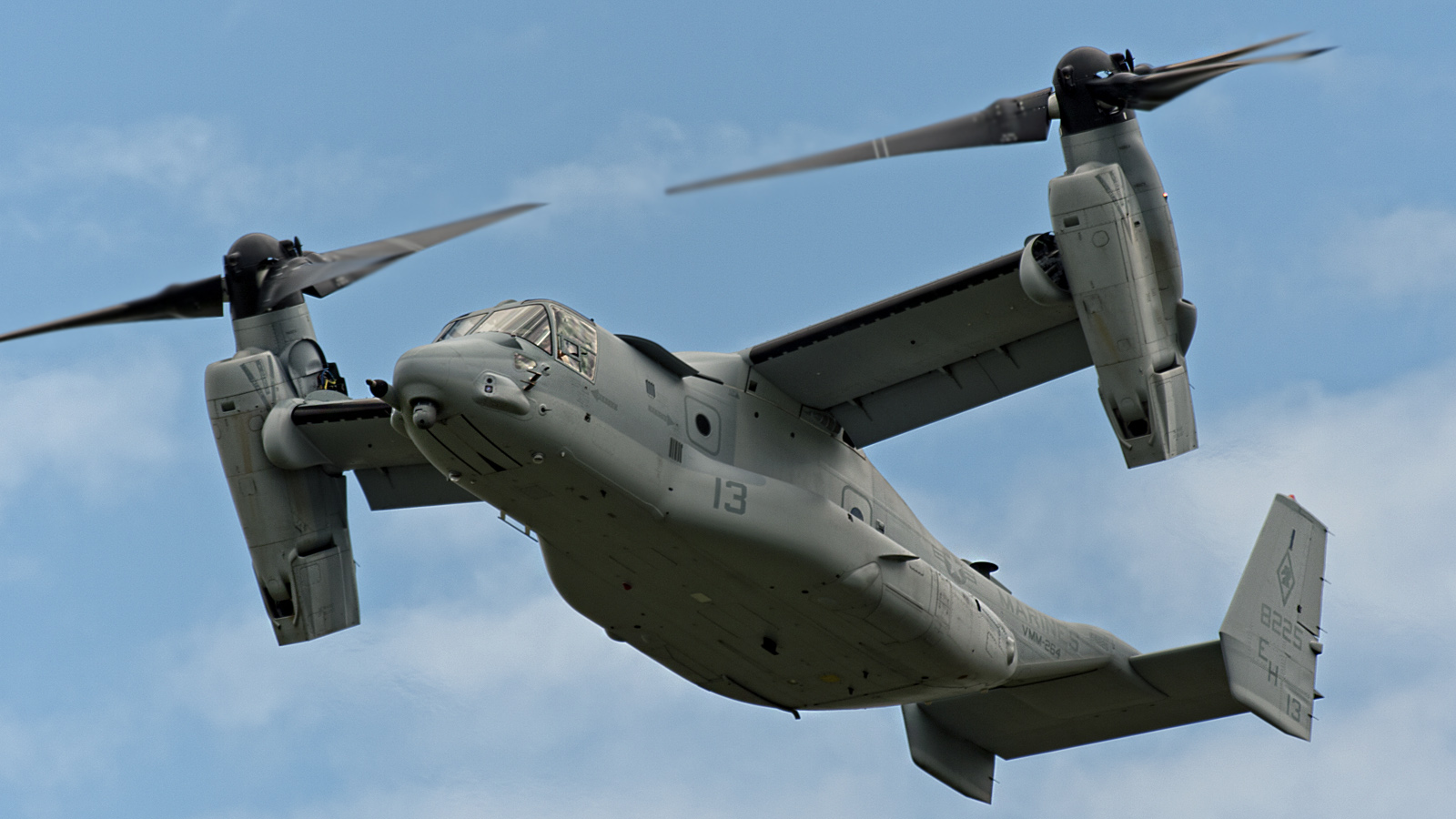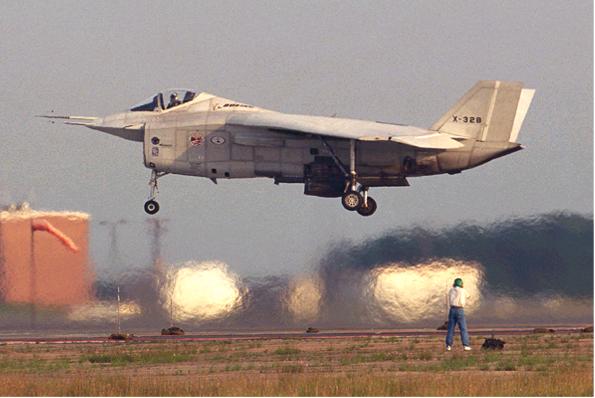
The Bell-Boeing V-22 Osprey is the world’s first production multi-mission, military, tiltrotor aircraft. V-22 successfully blends the vertical flight capabilities of helicopters with the speed, range, altitude, and endurance of fixed-wing transports. The V-22 was developed and is manufactured jointly by Bell Helicopter, and Boeing Rotorcraft Systems. The joint development team is known as Bell Boeing. Since entering service with the U.S. Marine Corps and Air Force, the Osprey has been deployed in both combat and rescue operations over Iraq, Afghanistan and Libya.
Developing nation: USA.
Manufacturer/designer: Bell Boeing.
Production Lines: Amarillo, Texas
Type aircraft: multi-mission, military, tiltrotor aircraft.
First flight: 19 March 1989.
First delivery: 13 June 2007.
State: in service.
Developed from: Bell XV-15.
The V-22 has been designed to the most stringent safety, reliability, readiness, all-weather operations, survivability, crash worthiness, and performance requirements of any rotary wing aircraft ever built. The V-22’s self-deployability and large payload capacity over long distances position it to support numerous missions worldwide.
Designed with folding rotors and a rotating wing, the V-22 fits nicely in the maritime base. It stores compactly on board an aircraft carrier or assault ship in a minimal footprint. With air-to-air refueling capability, it meets the U.S. Navy requirements for combat search and rescue, fleet logistics support, and special warfare support.
Composite materials were a key technology that enabled the development of the V-22 and reduced cost and weight, improved reliability, and increased ballistic tolerance. The past two ecades of extensive research and development on composite materials in the aerospace industry has directly benefited the V-22 structural design.
Two Rolls-Royce AE1107C Liberty engines provide the propulsion for the V-22. The AE1107C is a 6,150 shaft horsepower, two-spool, turboshaft, gas-turbine engine. The engines are located within the nacelles. The interconnect driveshaft provides safe one-engine-out flight in all modes of operation. An Engine Air Particle Separator (EAPS) is integral to the engine installation and can be selected to manual pilot control or automatic. Fire detection and extinguishing systems are provided in the engine compartments, wing bays and mid-wing areas.
A rotor brake assembly is integral to the mid-wing gearbox.
Variants
- V-22A – Pre-production full-scale development aircraft used for flight testing. These are unofficially considered A-variants after the 1993 redesign.
- EV-22 Proposed airborne early warning and control variant. The Royal Navy studied this AEW variant as a replacement for its current fleet of carrier-based Sea King ASaC.7 helicopters.
- HV-22 – The U.S. Navy considered an HV-22 to provide combat search and rescue, delivery and retrieval of special warfare teams along with fleet logistic support transport. It chose the MH-60S for this role in 2001. Naval Air Systems Command’s 2011/2012 V-22 Osprey Guidebook still lists the HV-22 for the U.S. Navy with the USAF and USMC variants.
- SV-22 – The proposed anti-submarine warfare variant. The U.S. Navy studied the SV-22 in the 1980s to replace S-3 and SH-2 aircraft.
- MV-22B – Basic U.S. Marine Corps transport; original requirement for 552 (now 360). The Marine Corps is the lead service in the development of the V-22 Osprey. The Marine Corps variant is an assault transport for troops, equipment and supplies, capable of operating from ships or from expeditionary airfields ashore. It is replacing the Marine Corps’ CH-46E and CH-53D.
- MV-22C – MV-22B with upgraded software and improved temperature controls.
- CV-22B – The U.S. Air Force variant for the U.S. Special Operations Command (USSOCOM). It conducts long-range, special operations missions, and is equipped with extra wing fuel tanks and an AN/APQ-186 terrain-following radar, along with other special operations equipment such as the AN/ALQ-211. The fuel capacity is increased by 588 gallons (2,230 L) with two inboard wing tanks; three auxiliary tanks (200 or 430 gal) can also be added in the cabin. The CV-22 replaced the MH-53 Pave Low helicopter.
Operators
- Under the current program of record, the Marine Corps will purchase 360 MV-22s for missions including amphibious assault, ship-to-objective maneuvers and sustained operations ashore.
- The Navy is also slated to get 48 MV-22s, which could be used for fleet logistic support and search and rescue.
- The Air Force Special Operations Command acquired 50 CV-22 variants, with enhanced capabilities tailored for their unique mission requirements. The CV-22 reached initial operational capability in 2009, while the Marines’ variant deployed in late 2007.
- The first operational Marine Osprey squadron, VMM-263, stood up at New River,NC, on March 3, 2006, with many of its pilots going through training at VMMT-204. The first operational AFSOC unit received the CV-22 was the 1st Special Operations Wing, Hurlburt Field, FL, on November 16, 2006.
Specifications (MV-22B)
General characteristics
- Crew: Four (pilot, copilot and two flight engineers/crew chiefs)
- Capacity:
- 24 troops (seated), 32 troops (floor loaded), or
- 9,070 kg (20,000 lb) of internal cargo, or up to 6,800 kg (15,000 lb) of external cargo (dual hook)
- 1× Growler light internally transportable ground vehicle
- Length: 17.5 m (57 ft 4 in)
- Rotor diameter: 11.6 m (38 ft 0 in)
- Wingspan: 14 m (45 ft 10 in)
- Width with rotors: 25.8 m (84 ft 7 in)
- Height: 6.73 m/22 ft 1 in; overall with nacelles vertical (5.5 m/17 ft 11 in; at top of tailfins)
- Disc area: 212 m² (2,268 ft²)
- Wing area: 28 m² (301.4 ft²)
- Empty weight: 15,032 kg (33,140 lb)
- Loaded weight: 21,500 kg (47,500 lb)
- Max. takeoff weight: 27,400 kg (60,500 lb)
- Powerplant: 2 × Rolls-Royce Allison T406/AE 1107C-Liberty turboshafts, 6,150 hp (4,590 kW) each
Performance
- Maximum speed: 509 km/h (275 knots, 316 mph) at sea level /565 km/h (305 kn; 351 mph) at 4,600 m (15,000 ft)
- Cruise speed: 446 km/h (241 knots, 277 mph) at sea level
- Stall speed: 210 km/h 126 mph, 110 knots) in airplane mode
- Range: 1,627 km (879 nmi, 1,011 mi)
- Combat radius: 722 km (390 nmi, 426 mi)
- Ferry range: 3,590 km (1,940 nmi, 2,230 mi) with auxiliary internal fuel tanks
- Service ceiling: 7,620 m (25,000 ft)
- Rate of climb: 11.8 m/s (2,320 – 4,000 ft/min)
- Glide ratio: 4.5:1
- Disc loading: 102.23 kg/m² (20.9 lb/ft² at 47,500 lb GW)
- Power/mass: 0.259 hp/lb (427 W/kg)
Armament
- 1× 7.62 mm (0.308 in) M240 machine gun or 0.50 in (12.7 mm) M2 Browning machine gun on ramp, removable
- 1× 7.62 mm (.308 in) GAU-17 minigun, belly-mounted, retractable, video remote control in the Remote Guardian System
All pictures courtesy of Zijde Aviation Photo and Publishing, Rob Vogelaar







